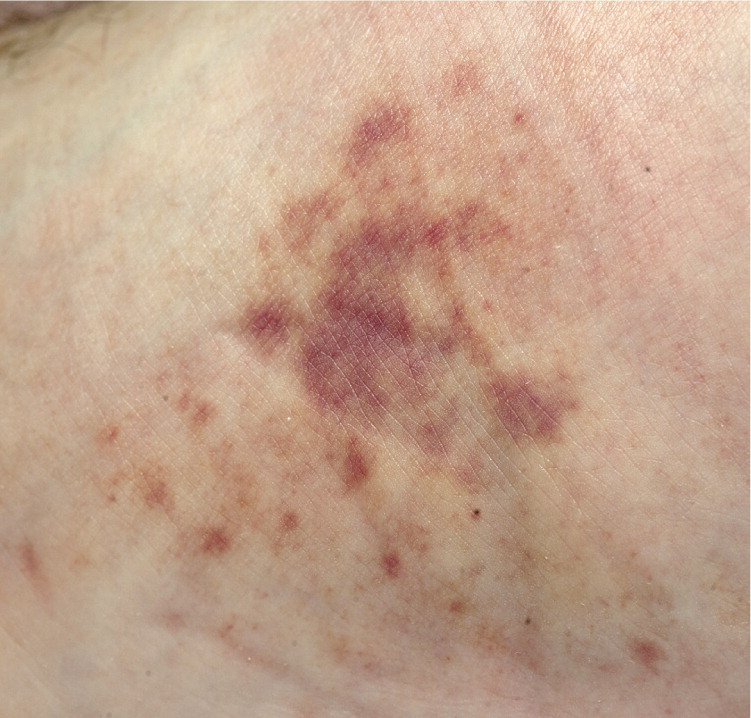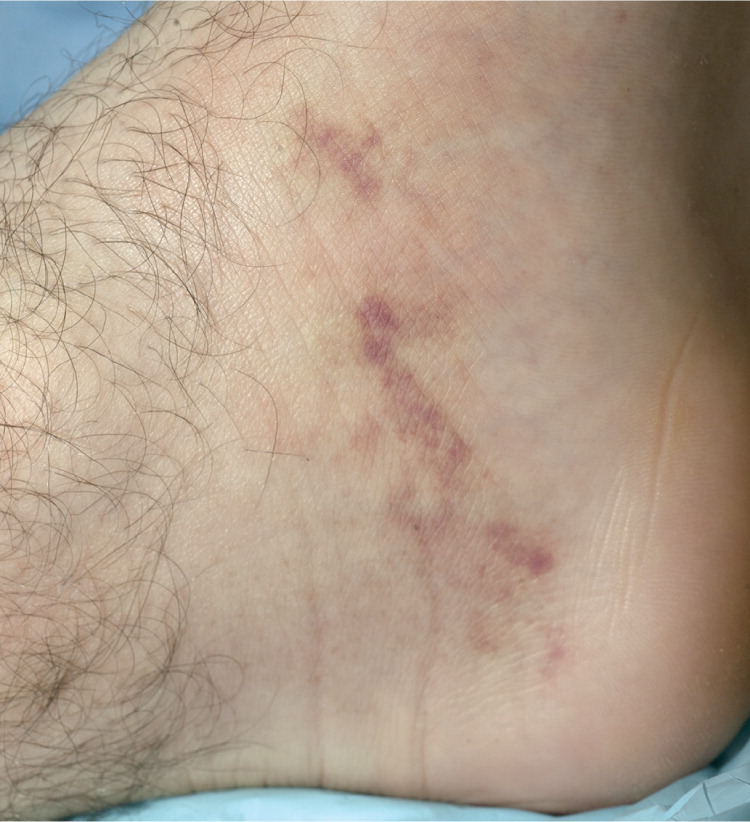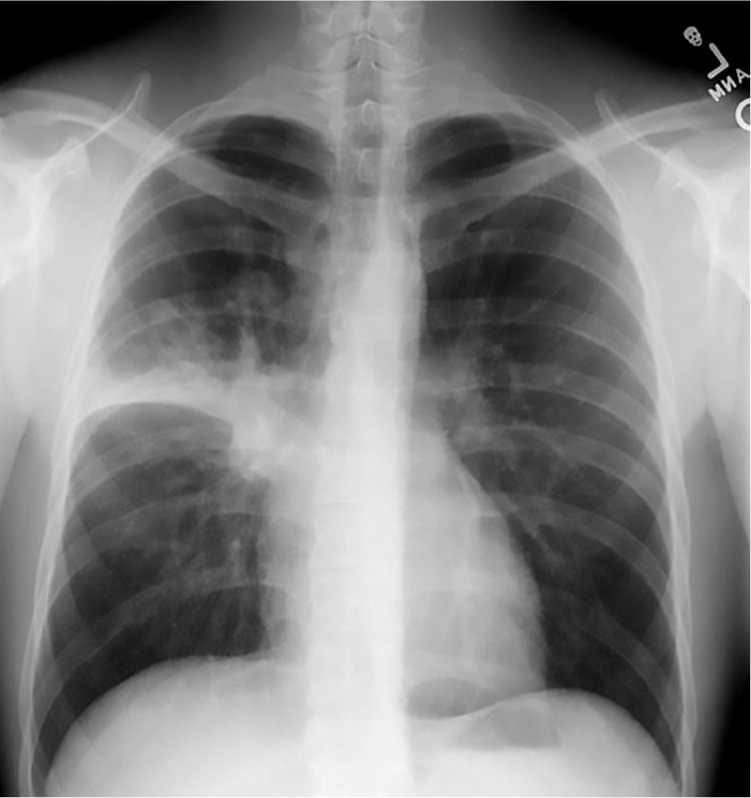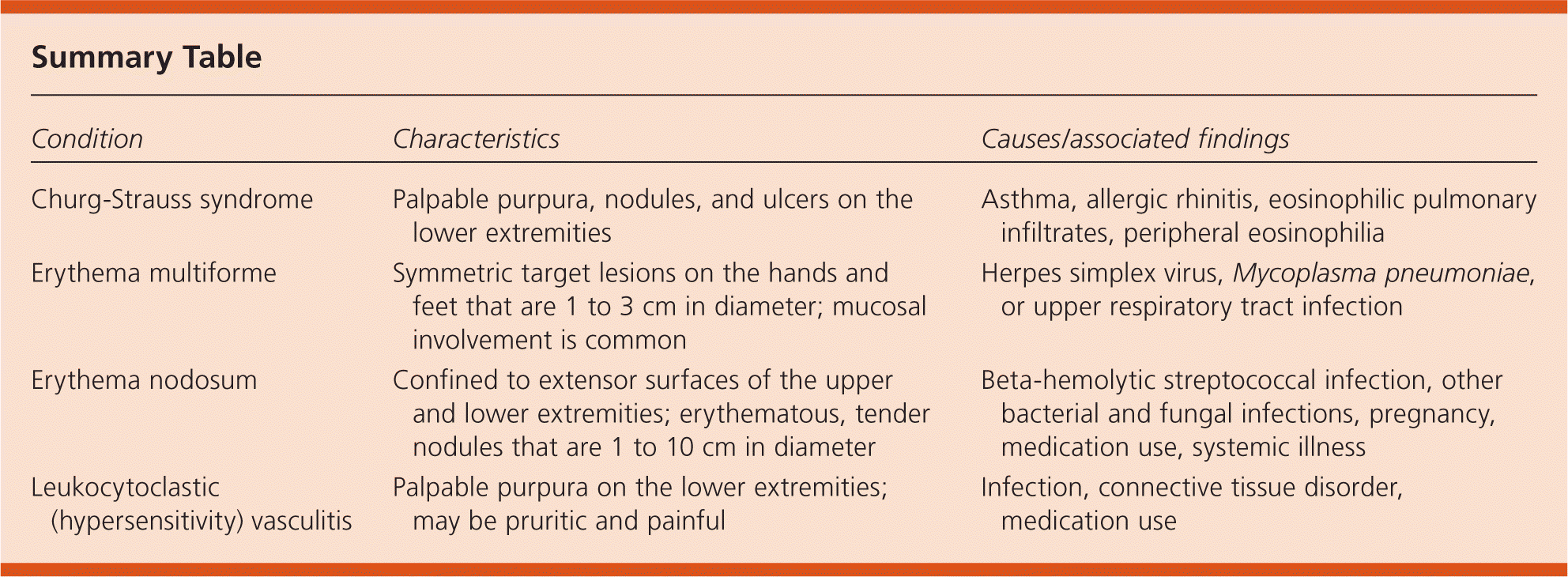
Am Fam Physician. 2014;90(3):181-182
Author disclosure: No relevant financial affiliations.
A 21-year-old man presented with fever, cough, arthralgias, and bilateral lower extremity rash and swelling that began 24 hours earlier. He had no history of asthma or seasonal allergies. He was not sexually active. He did not have a history of tick exposure or genitourinary symptoms.
On physical examination, he had a fever of 102°F (38.9°C) and a rash on both feet (Figures 1 and 2). The rash was erythematous, purpuric, and palpable. His white blood cell count was 10,500 per mm3 (10.5 × 109 per L) without eosinophilia. Platelet and red blood cell counts were normal. A urinalysis showed a trace amount of blood but no red blood cells, casts, or protein. Antineutrophil cytoplasmic antibody study results were negative. Chest radiography was performed (Figure 3).



Question
Discussion
The answer is D: leukocytoclastic vasculitis, which is also called hypersensitivity vasculitis. This is a small vessel vasculitis characterized by palpable purpura on the lower extremities.1 Lesions may be pruritic and painful and typically last weeks to months. The condition is recurrent in up to 10% of patients.2 Associated symptoms include fever, fatigue, myalgias, and migratory arthralgias.2 It may be preceded by infection, medication exposure, connective tissue disorder, or malignancy; however, 50% of cases are idiopathic.1
Initial diagnostic workup focuses on excluding infectious, rheumatologic, or malignant causes. Hepatitis C (19%) and hepatitis B (5%) are commonly associated infections.1 Medication use may cause up to 10% of cases, and symptoms typically manifest seven to 21 days after exposure. Penicillins, sulfonamides, quinolones, allopurinol (Zyloprim), and thiazides have been implicated.1 Rheumatoid arthritis, Sjögren syndrome, and lupus erythematosus are associated with leukocytoclastic vasculitis. Malignancy from any type of cancer can cause the condition, although it is uncommon. Treatment of the underlying condition or withdrawal of the offending agent is recommended; idiopathic cases can be treated symptomatically with antihistamines, nonsteroidal anti-inflammatory drugs, and steroids.3
Eosinophilic granulomatosis with polyangiitis (formerly Churg-Strauss syndrome) is a small vessel vasculitis that affects males 15 to 70 years of age.3 Patients develop palpable purpura, nodules, and ulcers on the lower extremities.3 The disease is associated with asthma, allergic rhinitis, eosinophilic pulmonary infiltrates, peripheral eosinophilia, and antineutrophil cytoplasmic antibodies.3,4
Erythema multiforme is a hypersensitivity syndrome characterized by target lesions with symmetric distribution on the hands and feet that may spread toward the trunk. The lesions may display a middle zone of pale edema and outer zone of erythema forming the “iris” target lesion, which is 1 to 3 cm in diameter.1 Mucosal lesions occur in 70% of cases.1 The condition is commonly associated with herpes simplex virus, Mycoplasma pneumoniae, and upper respiratory tract infections, although the cause is unknown in 50% of cases.1
Erythema nodosum is a hypersensitivity reaction involving the extensor surfaces of the upper and lower extremities. It is characterized by erythematous, tender, nodules that are 1 to 10 cm in diameter.5 The condition is associated with fungal and bacterial infections, pregnancy, medication use, and systemic illnesses (e.g., sarcoidosis, inflammatory bowel disease, Hodgkin disease); however, approximately 55% of cases are idiopathic.5 Beta-hemolytic streptococcal infections cause 44% of adult cases with an identifiable cause.5

| Condition | Characteristics | Causes/associated findings |
|---|---|---|
| Eosinophilic granulomatosis with polyangiitis (formerly Churg-Strauss syndrome) | Palpable purpura, nodules, and ulcers on the lower extremities | Asthma, allergic rhinitis, eosinophilic pulmonary infiltrates, peripheral eosinophilia |
| Erythema multiforme | Symmetric target lesions on the hands and feet that are 1 to 3 cm in diameter; mucosal involvement is common | Herpes simplex virus, Mycoplasma pneumoniae, or upper respiratory tract infection |
| Erythema nodosum | Confined to extensor surfaces of the upper and lower extremities; erythematous, tender nodules that are 1 to 10 cm in diameter | Beta-hemolytic streptococcal infection, other bacterial and fungal infections, pregnancy, medication use, systemic illness |
| Leukocytoclastic (hypersensitivity) vasculitis | Palpable purpura on the lower extremities; may be pruritic and painful | Infection, connective tissue disorder, medication use |
